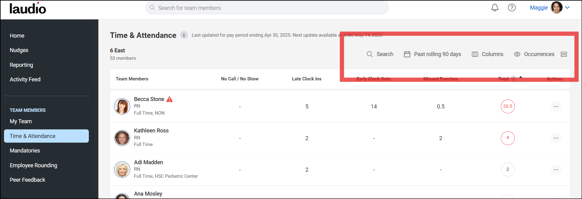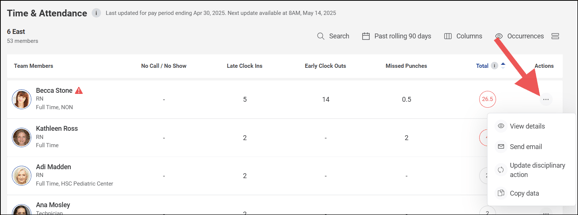Laudio receives time and attendance (T&A) data from your organization through a data feed from your T&A platform. This information is analyzed to identify key trends and surfaced in Laudio as actionable insights for leaders.
Key Benefits:
-
View time and attendance data in one central location, including unscheduled absences, late clock-ins, and missed punches.
- Actionable trends surfaced for you as the leader to help you check in with team members.
Taking Action in the Time & Attendance Workflow
-
Click Time & Attendance in the left navigation panel.
-
Search, filter, and set your default view.

-
Use the Take Action buttons to:
-
Send an email to staff
-
View more details
-
Copy information for use elsewhere
-

How Time & Attendance Data Is Calculated
The calculation methodology can be accessed directly in Laudio by clicking the information icon in the Time & Attendance view.![]()
Included in Calculations
-
Unscheduled absences: Only the first shift is included if multiple absences occur in a row. If an employee has an unscheduled absence, then works a shift, and later has another unscheduled absence, both absences are counted.
-
Missed punch / No show: Any shift with a missed punch or no show is counted.
-
Arriving late or leaving early: Only shifts outside the department’s standard shift start/end times and associated grace periods are included.
-
If a single shift has both a late arrival and early departure, only the late arrival is shown.
-
Excluded from Calculations
-
Any shift with a low census pay code.
-
Any shift where training, administrative, or meeting time accounts for more than 50% of total hours worked.
-
Any shift with Orientation pay codes.
-
Any shift that cannot be matched to a known worked shift (tagged as “Unknown” shift type).
-
Any shift where more than 50% of time is a scheduled absence (e.g., PTO).
-
Any employee who is not currently active (e.g., terminated).
Matching Worked Shifts to Standard Shifts
-
Actual punch-in/punch-out times are compared to all standard shifts for the employee’s department.
-
Shifts are matched to a standard shift if:
-
The start time is within 60 minutes of the standard shift start time.
-
The end time is no more than 30 minutes early and up to 5 hours later than the standard shift end time.
-
-
Exception: If a low census pay code is in place, these criteria are ignored.
-3.png?height=120&name=Laudio_Wordmark_RGB_Color%20(1)-3.png)